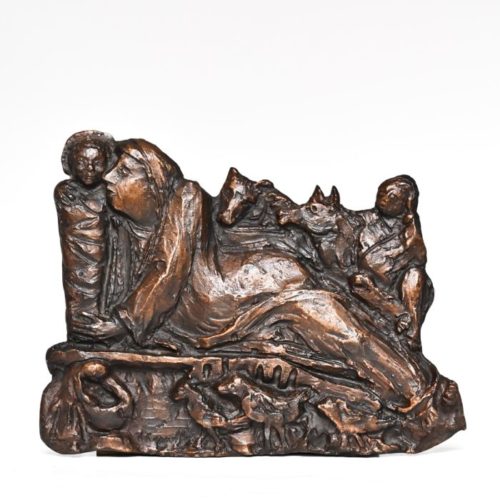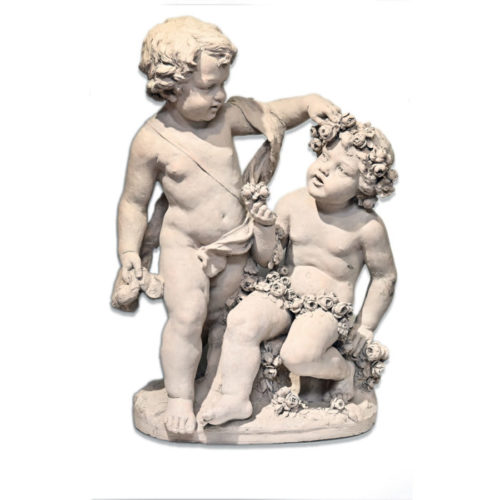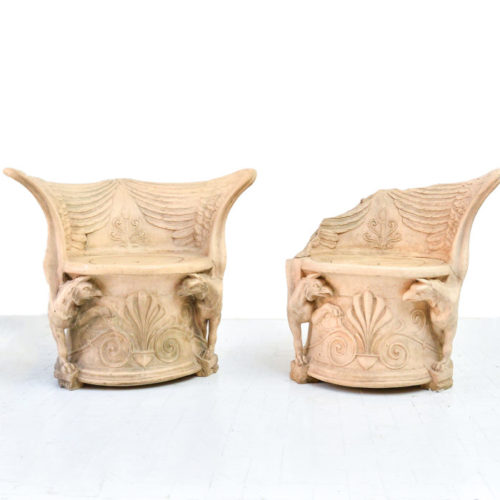-
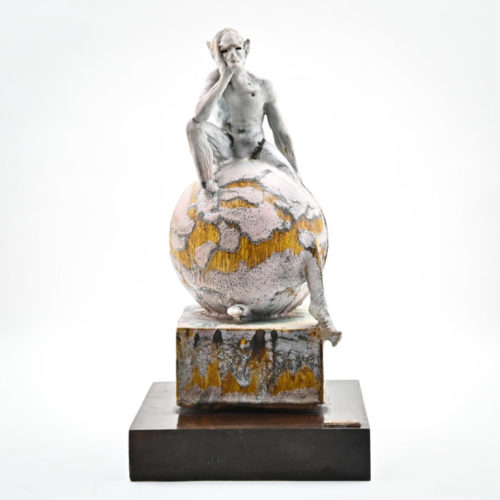 "La materia" ceramic sculpture by Angelo Basso (1943 - 2011), unique piece, label on the base. Presented at the 130th Figurative Arts Exhibition. Shown in the catalogue of the 130th Figurative Arts Exhibition, 27 October - 27 November 1972, of the Società Promotrice delle Belle Arti - Turin - Valentino Park. Period: 1972 Measurements: Sculpture measures H 36 x W 17 x D 16 cm / Base H 5 cm
"La materia" ceramic sculpture by Angelo Basso (1943 - 2011), unique piece, label on the base. Presented at the 130th Figurative Arts Exhibition. Shown in the catalogue of the 130th Figurative Arts Exhibition, 27 October - 27 November 1972, of the Società Promotrice delle Belle Arti - Turin - Valentino Park. Period: 1972 Measurements: Sculpture measures H 36 x W 17 x D 16 cm / Base H 5 cm -
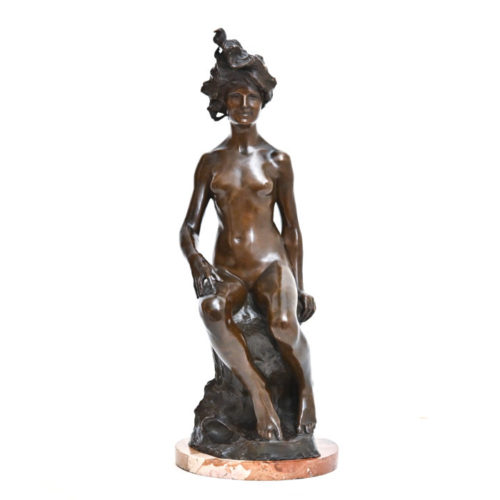 Bronze by Giovanni Nicolini, work of the 1920s / 1930s. Giovanni Nicolini was born in Palermo on April 14, 1872. He died in Rome in 1956. In the 1920s / 1930s the author focused his formal research on the theme of the nude figure, giving life to works strongly expressive of feelings or passions, in which the female figure with floating hair and enveloping shapes revealed a strong art nouveau influence. Period: 1920s / 30s Measurements: H with base 51 cm / H 49 x Ø base 19 cm
Bronze by Giovanni Nicolini, work of the 1920s / 1930s. Giovanni Nicolini was born in Palermo on April 14, 1872. He died in Rome in 1956. In the 1920s / 1930s the author focused his formal research on the theme of the nude figure, giving life to works strongly expressive of feelings or passions, in which the female figure with floating hair and enveloping shapes revealed a strong art nouveau influence. Period: 1920s / 30s Measurements: H with base 51 cm / H 49 x Ø base 19 cm -
Out of stock
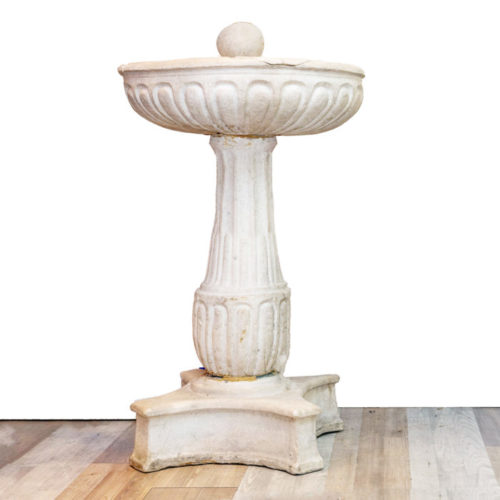 Ancient stoup in carved white marble, 17th century in good condition. Period: '600 Measurements: H 130 x D 64 cm
Ancient stoup in carved white marble, 17th century in good condition. Period: '600 Measurements: H 130 x D 64 cm -
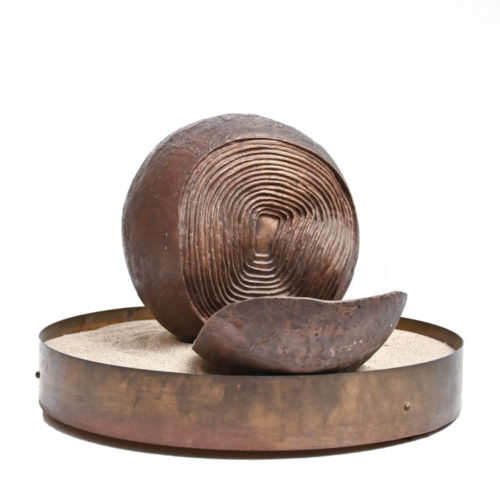 Period: 1976 Measurements: H32 x W48 x W48 cmBronze sculpture by Franco Zazzeri signed and dated 1976. "A sphere, and all of a sudden it breaks, a slice of it caught just in the moment of falling down (...) that sphere is configured as the earth that turns in spaces; what will become the segment that has detached from the sphere of Zazzeri? " - Marco Valsecchi 1977 (Milan, 1913 - 1980) - art critic, university professor, essayist and journalist of the daily newspapers Il Giorno and Il Giornale and of the weekly Lo Speciale. "Zazzeri's work can be called" totemism of the origins ": an anthropological function that rediscovers the notion of beauty in the recognition of an inner and eternal truth." - Riccardo Barletta 1985 - Modern art critic and professor of history of design at the Polytechnic School of Milan. "Cosmos and Logos are converted into each other, through the filter of the protean personality of Zazzeri" - Floriano De Santi 1999 - Artistic Director and Critic and art historian FRANCO ZAZZERI was born in Florence on 19 August 1938. He spent his childhood in Monte San Savino, Arezzo. At the age of fourteen he began working in a ceramics workshop but, fascinated by sculpture, he moved to Arezzo where he worked for a local marble worker and attended the Aretina art school under the guidance of the sculptor Giovanni Bianchi. At the end of the 1950s, commissioned by various personalities from Arezzo, he made several sculptural portraits; he wins the competition for the construction of the statue of the Madonna delle Vertighe (patron saint of the Autostrada del Sole). In 1960 he moved to Milan (where he currently lives and works). In the same year he graduated from the school of the Castello Sforzesco sculpture section. To his credit 30 personal exhibitions held in Italy and Europe. Numerous group exhibitions; we cite some of the most prestigious: 1983 "Italian sculpture in the world" traveling exhibition in the main cities of the world by the Ministry of Foreign Affairs and the Rome Quadrennial of Art; 1984 "XXIX Biennale of Art of the City of Milan", Palazzo della Permanente; 1986 "XLII International Biennial of Art of Venice"; 1989 "XXXI Biennale of Art of the City of Milan", Palazzo della Permanente; 1999 "XIII Quadrennial of Rome". Some of his sculptures are found in: Montecarlo - Banque de Gestion Monegasque; Rome - EUR - Italian Credit; Rome - via del corso 374 - Credito Italiano; Turin - in via Arsenale, 11 - Credito Italiano; Moscow - Italian Representation; Milan - Linate and Malpensa Airport; Milan - Municipality of Milan in via Pirelli; Milan - Piazza Duca d'Aosta; Milan - Civic Center - via Oglio 18; Here below we mention only a few other exhibitions, by importance and artistic significance: 2002 Milan, Palazzo Municipale Sondrio; 1995-1999-2005 Milan, Borgogna Gallery; 1989 Monte San Savino, "Homage to Sansovino"; 1984 Munich, Galerie Museum BMW; 1984 Vienna, Italian Cultural Institute; 1980 Ferrara, Palazzo Dei Diamanti; 1975-1979-1983 Ada Zunino Gallery; 1971-1974 Monza, Arengario Museum; 1970-1971-1972-1973 Milan, 'La Darsena' Gallery. "... Starting from a figurative sculpture Franco Zarreri soon turns to a more informal vision of the figure, a non-individual content emerges from the representation of the individual to that of the group, the family nucleus, seen as a reality of the primordium in a genetic sense . A non-descriptive and unrealistic position. ... " from "Zarreri - The Totemism of Origins" Riccardo Barletta ed. Milan Point and Line
Period: 1976 Measurements: H32 x W48 x W48 cmBronze sculpture by Franco Zazzeri signed and dated 1976. "A sphere, and all of a sudden it breaks, a slice of it caught just in the moment of falling down (...) that sphere is configured as the earth that turns in spaces; what will become the segment that has detached from the sphere of Zazzeri? " - Marco Valsecchi 1977 (Milan, 1913 - 1980) - art critic, university professor, essayist and journalist of the daily newspapers Il Giorno and Il Giornale and of the weekly Lo Speciale. "Zazzeri's work can be called" totemism of the origins ": an anthropological function that rediscovers the notion of beauty in the recognition of an inner and eternal truth." - Riccardo Barletta 1985 - Modern art critic and professor of history of design at the Polytechnic School of Milan. "Cosmos and Logos are converted into each other, through the filter of the protean personality of Zazzeri" - Floriano De Santi 1999 - Artistic Director and Critic and art historian FRANCO ZAZZERI was born in Florence on 19 August 1938. He spent his childhood in Monte San Savino, Arezzo. At the age of fourteen he began working in a ceramics workshop but, fascinated by sculpture, he moved to Arezzo where he worked for a local marble worker and attended the Aretina art school under the guidance of the sculptor Giovanni Bianchi. At the end of the 1950s, commissioned by various personalities from Arezzo, he made several sculptural portraits; he wins the competition for the construction of the statue of the Madonna delle Vertighe (patron saint of the Autostrada del Sole). In 1960 he moved to Milan (where he currently lives and works). In the same year he graduated from the school of the Castello Sforzesco sculpture section. To his credit 30 personal exhibitions held in Italy and Europe. Numerous group exhibitions; we cite some of the most prestigious: 1983 "Italian sculpture in the world" traveling exhibition in the main cities of the world by the Ministry of Foreign Affairs and the Rome Quadrennial of Art; 1984 "XXIX Biennale of Art of the City of Milan", Palazzo della Permanente; 1986 "XLII International Biennial of Art of Venice"; 1989 "XXXI Biennale of Art of the City of Milan", Palazzo della Permanente; 1999 "XIII Quadrennial of Rome". Some of his sculptures are found in: Montecarlo - Banque de Gestion Monegasque; Rome - EUR - Italian Credit; Rome - via del corso 374 - Credito Italiano; Turin - in via Arsenale, 11 - Credito Italiano; Moscow - Italian Representation; Milan - Linate and Malpensa Airport; Milan - Municipality of Milan in via Pirelli; Milan - Piazza Duca d'Aosta; Milan - Civic Center - via Oglio 18; Here below we mention only a few other exhibitions, by importance and artistic significance: 2002 Milan, Palazzo Municipale Sondrio; 1995-1999-2005 Milan, Borgogna Gallery; 1989 Monte San Savino, "Homage to Sansovino"; 1984 Munich, Galerie Museum BMW; 1984 Vienna, Italian Cultural Institute; 1980 Ferrara, Palazzo Dei Diamanti; 1975-1979-1983 Ada Zunino Gallery; 1971-1974 Monza, Arengario Museum; 1970-1971-1972-1973 Milan, 'La Darsena' Gallery. "... Starting from a figurative sculpture Franco Zarreri soon turns to a more informal vision of the figure, a non-individual content emerges from the representation of the individual to that of the group, the family nucleus, seen as a reality of the primordium in a genetic sense . A non-descriptive and unrealistic position. ... " from "Zarreri - The Totemism of Origins" Riccardo Barletta ed. Milan Point and Line -
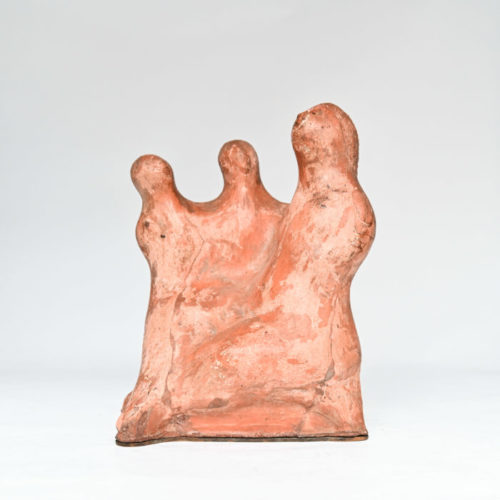 Period: 1949 Measurements: H 35 x W 26 x D 20 cmTerracotta sculpture by Carmelo Cappello (Ragusa, 21 May 1912 - Milan, 21 December 1996) signed and dated 1949. CARMELO CAPPELLO (Ragusa 1912 - Milan 1996) He attended the Comiso School of Art. Trained at a very young age in Ettore Colla's studio, he moved to Milan in the 30th. Thanks to a scholarship he follows the courses of Marino Marini at the Istituto Superiore di Monza. In 37 he made his debut as a sculptor and the following year he held his first solo show at the Bragaglia Gallery in Rome. In 41 he consolidated his friendship with Giò Ponti, which later became a close collaboration. He has participated numerous times in the Venice Biennale, the Rome Quadriennale and the Milan Triennale. In 59 he was invited to Documenta 2 in Kassel. After the first figurative phase, struck by Moore's modern European sculpture, he passes from Tatlin's Russian Constructivism to the discoveries of the filtering space of Pevsner, Brancusi and Gabo: these are the cultural matrices, in his artistic iter, of his original declination of pure linear rhythms and volumetric that constitute the fulcrum of his mature language. Constant components of its structures are the curve, linked in the circle or marked in the ellipsis, in a rigorous equilibrium of two-dimensional relationships. In Ragusa, in 94, the Civic Collection Cappello was inaugurated, the result of the donation of 15 sculptures and 20 graphic works that formed the starting point of the Museum dedicated to him in 55. Good production of multiples and graphics of his maturity.
Period: 1949 Measurements: H 35 x W 26 x D 20 cmTerracotta sculpture by Carmelo Cappello (Ragusa, 21 May 1912 - Milan, 21 December 1996) signed and dated 1949. CARMELO CAPPELLO (Ragusa 1912 - Milan 1996) He attended the Comiso School of Art. Trained at a very young age in Ettore Colla's studio, he moved to Milan in the 30th. Thanks to a scholarship he follows the courses of Marino Marini at the Istituto Superiore di Monza. In 37 he made his debut as a sculptor and the following year he held his first solo show at the Bragaglia Gallery in Rome. In 41 he consolidated his friendship with Giò Ponti, which later became a close collaboration. He has participated numerous times in the Venice Biennale, the Rome Quadriennale and the Milan Triennale. In 59 he was invited to Documenta 2 in Kassel. After the first figurative phase, struck by Moore's modern European sculpture, he passes from Tatlin's Russian Constructivism to the discoveries of the filtering space of Pevsner, Brancusi and Gabo: these are the cultural matrices, in his artistic iter, of his original declination of pure linear rhythms and volumetric that constitute the fulcrum of his mature language. Constant components of its structures are the curve, linked in the circle or marked in the ellipsis, in a rigorous equilibrium of two-dimensional relationships. In Ragusa, in 94, the Civic Collection Cappello was inaugurated, the result of the donation of 15 sculptures and 20 graphic works that formed the starting point of the Museum dedicated to him in 55. Good production of multiples and graphics of his maturity. -
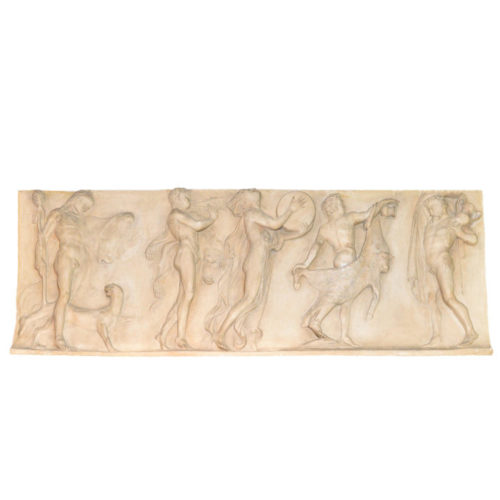 Period: Early 1900s Measurements: H 58 x W 157 x D 10 cmTerracotta panel depicting a classical scene. On the back the Manifattura di Signa brand. In excellent condition. The Manifattura di Signa is a historic terracotta pottery workshop. It was created in 1895 by the will of Camillo Bondi. "At the beginning of the twentieth century Signa was still one of the major industrial centers of straw. To that industry, which had made the name of the town known beyond national borders, was added another activity which, since the last five years of the nineteenth century and in a short space of years, it would have relaunched its name on the European and American markets: the artistic terracotta industry "Manifattura di Signa", founded in Signa (Florence), in 1895 by Camillo Bondi, on the premises of the factory " Fornaci di Signa "owned by his brother Angelo. At that time, the taste for antique fakes continued to seduce with all its charm, and in ceramics the interest in tradition had prompted the most important Italian manufacturers to revisit shapes and decorations Renaissance, reaching the ancient virtuosity of the historiated and grotesques with a high craftsmanship. If those productions interpreted the ancient with typical nineteenth-century eclecticism, the Manifattura di Signa on the other hand, it generated the perfect resemblance of the truth, both through the forms used when possible on the original, and by means of patinas simulating those of marbles and bronzes and even the faults of time, in order to obtain the appearance of the authentic piece, and visually as well as tactile and, in some bronzes, also sound. With this spirit, reproductions of sculptural and decorative masterpieces of all times will take shape from the Arno mud: from Etruscan to Greek statuary, from Roman to Renaissance, from Moorish vases to contemporary Art Nouveau creations. The success that ensued is witnessed by numerous exhibition awards such as the medal at the Universal Expo in Paris in 1900, where he exhibited numerous plastic terracotta, suitable for decorating the exteriors, with a particular patination that made it look better and more resistant to agents. atmospheric, soon expanded the number of occupations and the specialization of young artists assisted by the experience of sculptors of excellent fame, called to Signa for new ideas by the Bondi brothers, the brilliant founders and conductors of the Manufacture, coming from a family of Leghorn Jewish high bourgeoisie and close to the intellectual and anti-positivist environment of the Florentine magazine of “Il Marzocco”. With the new industry an informal school of young workers was thus generated in the Signe who, despite lacking regular education, growing under the experience of sculptors and in contact with the most sublime models of universal classicism, a real concentrate of museums in the world , were naturally stimulated and educated in the beauty and proportions of forms, so much so that they became refined craftsmen, plasticizers, sculptors, able to give life to other similar manufactories. " There are many artists who have collaborated with the Signa Manufacture: Oreste Calzolari, Giovanni Prini, Giulio Cantalamessa, Adolf von Hildebrand, Raffaello Romanelli, Giuseppe Santelli, Renato Bertelli, Giovan Battista Casanova, Bruno Catarzi, Italo Griselli
Period: Early 1900s Measurements: H 58 x W 157 x D 10 cmTerracotta panel depicting a classical scene. On the back the Manifattura di Signa brand. In excellent condition. The Manifattura di Signa is a historic terracotta pottery workshop. It was created in 1895 by the will of Camillo Bondi. "At the beginning of the twentieth century Signa was still one of the major industrial centers of straw. To that industry, which had made the name of the town known beyond national borders, was added another activity which, since the last five years of the nineteenth century and in a short space of years, it would have relaunched its name on the European and American markets: the artistic terracotta industry "Manifattura di Signa", founded in Signa (Florence), in 1895 by Camillo Bondi, on the premises of the factory " Fornaci di Signa "owned by his brother Angelo. At that time, the taste for antique fakes continued to seduce with all its charm, and in ceramics the interest in tradition had prompted the most important Italian manufacturers to revisit shapes and decorations Renaissance, reaching the ancient virtuosity of the historiated and grotesques with a high craftsmanship. If those productions interpreted the ancient with typical nineteenth-century eclecticism, the Manifattura di Signa on the other hand, it generated the perfect resemblance of the truth, both through the forms used when possible on the original, and by means of patinas simulating those of marbles and bronzes and even the faults of time, in order to obtain the appearance of the authentic piece, and visually as well as tactile and, in some bronzes, also sound. With this spirit, reproductions of sculptural and decorative masterpieces of all times will take shape from the Arno mud: from Etruscan to Greek statuary, from Roman to Renaissance, from Moorish vases to contemporary Art Nouveau creations. The success that ensued is witnessed by numerous exhibition awards such as the medal at the Universal Expo in Paris in 1900, where he exhibited numerous plastic terracotta, suitable for decorating the exteriors, with a particular patination that made it look better and more resistant to agents. atmospheric, soon expanded the number of occupations and the specialization of young artists assisted by the experience of sculptors of excellent fame, called to Signa for new ideas by the Bondi brothers, the brilliant founders and conductors of the Manufacture, coming from a family of Leghorn Jewish high bourgeoisie and close to the intellectual and anti-positivist environment of the Florentine magazine of “Il Marzocco”. With the new industry an informal school of young workers was thus generated in the Signe who, despite lacking regular education, growing under the experience of sculptors and in contact with the most sublime models of universal classicism, a real concentrate of museums in the world , were naturally stimulated and educated in the beauty and proportions of forms, so much so that they became refined craftsmen, plasticizers, sculptors, able to give life to other similar manufactories. " There are many artists who have collaborated with the Signa Manufacture: Oreste Calzolari, Giovanni Prini, Giulio Cantalamessa, Adolf von Hildebrand, Raffaello Romanelli, Giuseppe Santelli, Renato Bertelli, Giovan Battista Casanova, Bruno Catarzi, Italo Griselli -
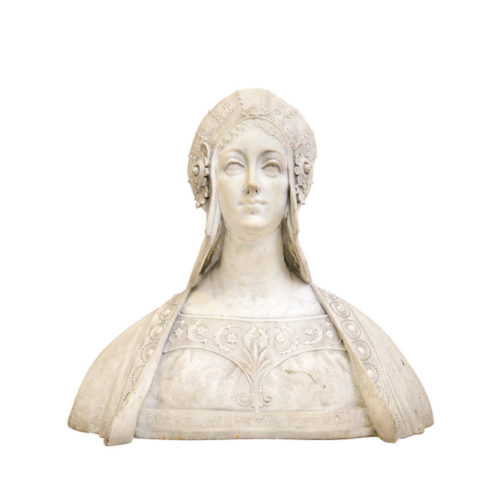 "Florentine noble lady " - Ancient Italian marble from the second half of the 19th century. Tuscan half-bust of exquisite workmanship depicting a noble Florentine lady. Perfectly finished in detail. It bears the inscription"Decus Augusta Coenobili". In good state of conservation and beautiful patina.Period: Second half of the 19th century Measurements: H 66 x W 78 x D 30 cm
"Florentine noble lady " - Ancient Italian marble from the second half of the 19th century. Tuscan half-bust of exquisite workmanship depicting a noble Florentine lady. Perfectly finished in detail. It bears the inscription"Decus Augusta Coenobili". In good state of conservation and beautiful patina.Period: Second half of the 19th century Measurements: H 66 x W 78 x D 30 cm
